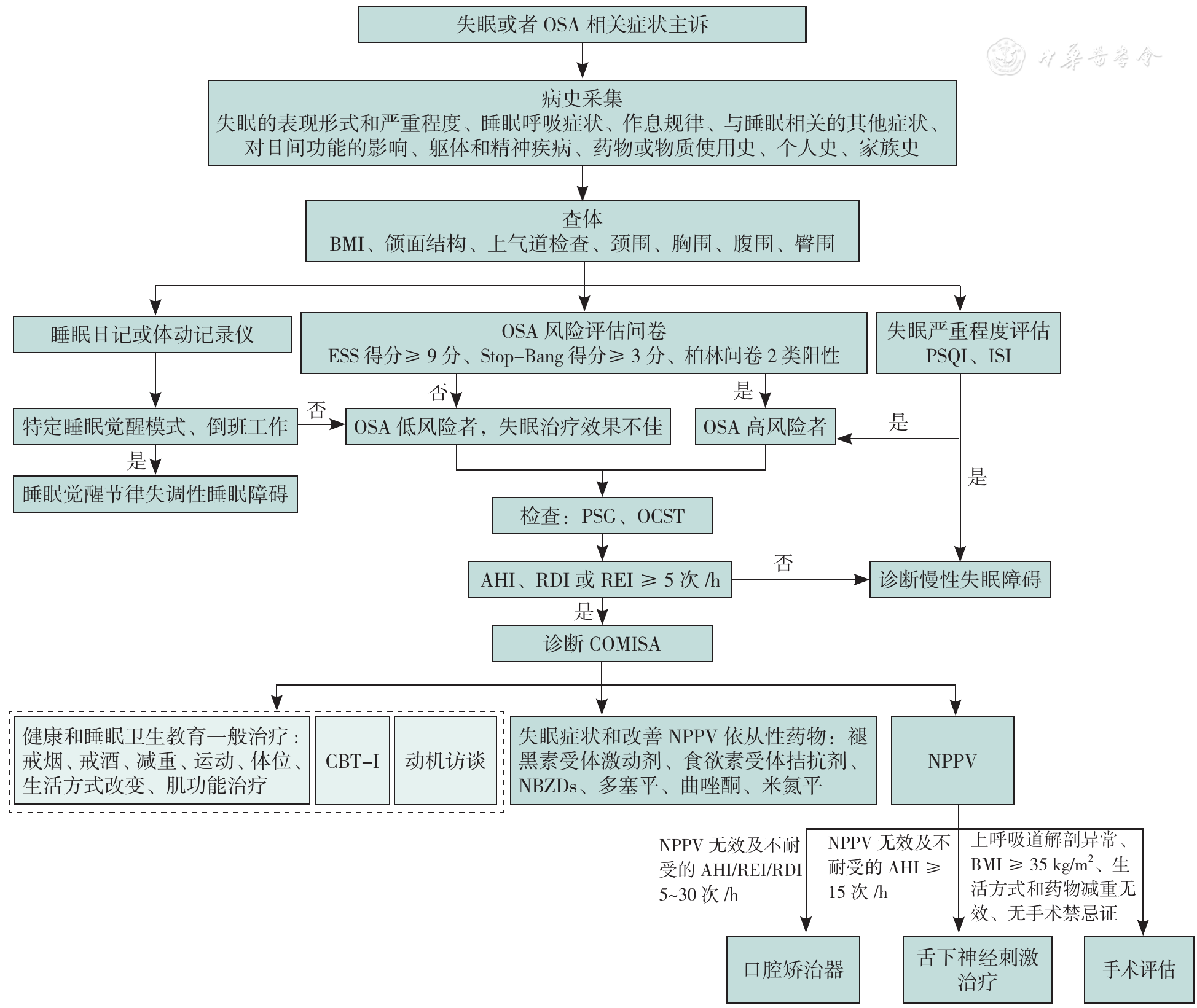| [63] |
EDINGER J D,ARNEDT J T,BERTISCH S M,et al. Behavioral and psychological treatments for chronic insomnia disorder in adults:an American Academy of Sleep Medicine clinical practice guideline[J]. J Clin Sleep Med,2021,17(2):255-262.
|
| [64] |
SWEETMAN A, LACK L, CATCHESIDE P G,et al. Cognitive and behavioral therapy for insomnia increases the use of continuous positive airway pressure therapy in obstructive sleep apnea participants with comorbid insomnia:a randomized clinical trial[J]. Sleep, 2019, 42(12):zsz178. DOI: 10.1093/sleep/zsz178.
|
| [65] |
CROSBY E S, SPITZER E G, KAVOOKJIAN J. Motivational interviewing effects on positive airway pressure therapy(PAP)adherence:a systematic review and meta-analysis of randomized controlled trials[J]. Behav Sleep Med, 2023, 21(4):460-487. DOI: 10.1080/15402002.2022.2108033.
|
| [66] |
BARRETT S, BEGG S, O'HALLORAN P,et al. Integrated motivational interviewing and cognitive behaviour therapy for lifestyle mediators of overweight and obesity in community-dwelling adults:a systematic review and meta-analyses[J]. BMC Public Health, 2018, 18(1):1160. DOI: 10.1186/s12889-018-6062-9.
|
| [67] |
MARKER I, NORTON P J. The efficacy of incorporating motivational interviewing to cognitive behavior therapy for anxiety disorders:a review and meta-analysis[J]. Clin Psychol Rev, 2018, 62:1-10. DOI: 10.1016/j.cpr.2018.04.004.
|
| [68] |
RUEDA J R, MUGUETA-AGUINAGA I, VILARÓ J,et al. Myofunctional therapy(oropharyngeal exercises)for obstructive sleep apnoea[J]. Cochrane Database Syst Rev, 2020, 11(11):CD013449. DOI: 10.1002/14651858.CD013449.pub2.
|
| [69] |
PENG J L, YUAN Y L, ZHAO Y H,et al. Effects of exercise on patients with obstructive sleep apnea:a systematic review and meta-analysis[J]. Int J Environ Res Public Health, 2022, 19(17):10845. DOI: 10.3390/ijerph191710845.
|
| [70] |
IFTIKHAR I H, BITTENCOURT L, YOUNGSTEDT S D,et al. Comparative efficacy of CPAP,MADs,exercise-training,and dietary weight loss for sleep apnea:a network meta-analysis[J]. Sleep Med, 2017, 30:7-14. DOI: 10.1016/j.sleep.2016.06.001.
|
| [71] |
D'AUREA C V R, FRANGE C, POYARES D,et al. Physical exercise as a therapeutic approach for adults with insomnia:systematic review and meta-analysis[J]. Einstein, 2022, 20:eAO8058. DOI: 10.31744/einstein_journal/2022AO8058.
|
| [1] |
GUILLEMINAULT C, ELDRIDGE F L, DEMENT W C. Insomnia with sleep apnea:a new syndrome[J]. Science, 1973, 181(4102):856-858. DOI: 10.1126/science.181.4102.856.
|
| [2] |
SWEETMAN A M, LACK L C, CATCHESIDE P G,et al. Developing a successful treatment for co-morbid insomnia and sleep apnoea[J]. Sleep Med Rev, 2017, 33:28-38. DOI: 10.1016/j.smrv.2016.04.004.
|
| [3] |
LECHAT B, LOFFLER K A, WALLACE D M,et al. All-cause mortality in people with co-occurring insomnia symptoms and sleep apnea:analysis of the Wisconsin sleep cohort[J]. Nat Sci Sleep, 2022, 14:1817-1828. DOI: 10.2147/NSS.S379252.
|
| [4] |
LECHAT B, APPLETON S, MELAKU Y A,et al. Comorbid insomnia and sleep apnoea is associated with all-cause mortality[J]. Eur Respir J, 2022, 60(1):2101958. DOI: 10.1183/13993003.01958-2021.
|
| [5] |
SWEETMAN A, LECHAT B, APPLETON S,et al. Association of co-morbid insomnia and sleep apnoea symptoms with all-cause mortality:analysis of the NHANES 2005-2008 data[J]. Sleep Epidemiol, 2022, 2:100043. DOI: 10.1016/j.sleepe.2022.100043.
|
| [6] |
CADE B E, REDLINE S. Heritability and genetic correlations for sleep apnea,insomnia,and hypersomnia in a large clinical biobank[J]. Sleep Health, 2024, 10(1S):S157-160. DOI: 10.1016/j.sleh.2023.11.002.
|
| [7] |
杨克虎. 世界卫生组织指南制订手册 [M].兰州:兰州大学出版社,2013.
|
| [8] |
|
| [9] |
ZHANG Y, REN R, LEI F,et al. Worldwide and regional prevalence rates of co-occurrence of insomnia and insomnia symptoms with obstructive sleep apnea:a systematic review and meta-analysis[J]. Sleep Med Rev, 2019, 45:1-17. DOI: 10.1016/j.smrv.2019.01.004.
|
| [10] |
CHO Y W, KIM K T, MOON H J,et al. Comorbid insomnia with obstructive sleep apnea:clinical characteristics and risk factors[J]. J Clin Sleep Med, 2018, 14(3):409-417. DOI: 10.5664/jcsm.6988.
|
| [72] |
LI S S, LI Z C, WU Q J,et al. Effect of exercise intervention on primary insomnia:a meta-analysis[J]. J Sports Med Phys Fitness, 2021, 61(6):857-866. DOI: 10.23736/S0022-4707.21.11443-4.
|
| [73] |
LARUN L,BRURBERG K G,ODGAARD-JENSEN J,et al. Exercise therapy for chronic fatigue syndrome[J]. Cochrane Database Syst Rev,2017,4(4):CD003200.
|
| [74] |
|
| [75] |
GAISL T, HAILE S R, THIEL S,et al. Efficacy of pharmacotherapy for OSA in adults:a systematic review and network meta-analysis[J]. Sleep Med Rev, 2019, 46:74-86. DOI: 10.1016/j.smrv.2019.04.009.
|
| [76] |
WANG S H, CHEN W S, TANG S E,et al. Benzodiazepines associated with acute respiratory failure in patients with obstructive sleep apnea[J]. Front Pharmacol, 2018, 9:1513. DOI: 10.3389/fphar.2018.01513.
|
| [77] |
ZHANG X J, LI Q Y, WANG Y,et al. The effect of non-benzodiazepine hypnotics on sleep quality and severity in patients with OSA:a meta-analysis[J]. Schlaf Atmung, 2014, 18(4):781-789. DOI: 10.1007/s11325-014-0943-7.
|
| [78] |
NIGAM G,CAMACHO M,RIAZ M. The effect of nonbenzodiazepines sedative hypnotics on apnea-hypopnea index:a meta-analysis[J]. Ann Thorac Med,2019,14(1):49-55.
|
| [79] |
WANG D H, TANG Y K, CHEN Y H,et al. The effect of non-benzodiazepine sedative hypnotics on CPAP adherence in patients with OSA:a systematic review and meta-analysis[J]. Sleep, 2021, 44(8):zsab077. DOI: 10.1093/sleep/zsab077.
|
| [80] |
CHOI K, LEE Y J, PARK S,et al. Efficacy of melatonin for chronic insomnia:systematic reviews and meta-analyses[J]. Sleep Med Rev, 2022, 66:101692. DOI: 10.1016/j.smrv.2022.101692.
|
| [11] |
STRAUSZ S, RUOTSALAINEN S, OLLILA H M,et al. Genetic analysis of obstructive sleep apnoea discovers a strong association with cardiometabolic health[J]. Eur Respir J, 2021, 57(5):2003091. DOI: 10.1183/13993003.03091-2020.
|
| [12] |
QIAN Y Y, DHARMAGE S C, HAMILTON G S,et al. Longitudinal risk factors for obstructive sleep apnea:a systematic review[J]. Sleep Med Rev, 2023, 71:101838. DOI: 10.1016/j.smrv.2023.101838.
|
| [13] |
TAN X, ALÉN M, CHENG S M,et al. Associations of disordered sleep with body fat distribution,physical activity and diet among overweight middle-aged men[J]. J Sleep Res, 2015, 24(4):414-424. DOI: 10.1111/jsr.12283.
|
| [14] |
DUARTE R L M, MAGALHÃES-DA-SILVEIRA F J, GOZAL D. Predictive factors for obstructive sleep apnea diagnosis in bariatric surgery candidates with or without chronic insomnia complaints[J]. Obes Surg, 2022, 32(1):33-41. DOI: 10.1007/s11695-021-05748-5.
|
| [15] |
CODRON F, BAILLY S, PEPIN J L,et al. Sleep characteristics of a population of patients seeking bariatric surgery[J]. Rev Mal Respir, 2021, 38(4):337-345. DOI: 10.1016/j.rmr.2020.12.006.
|
| [16] |
|
| [17] |
LIU P F, CHEN Q H, YUAN F,et al. Clinical predictors of mixed apneas in patients with obstructive sleep apnea(OSA)[J]. Nat Sci Sleep, 2022, 14:373-380. DOI: 10.2147/NSS.S351946.
|
| [18] |
HSU T W, CHEN H M, CHEN T Y,et al. The association between use of benzodiazepine receptor agonists and the risk of obstructive sleep apnea:a nationwide population-based nested case-control study[J]. Int J Environ Res Public Health, 2021, 18(18):9720. DOI: 10.3390/ijerph18189720.
|
| [19] |
CHAKRAVORTY S, CHAUDHARY N S, BROWER K J. Alcohol dependence and its relationship with insomnia and other sleep disorders[J]. Alcohol Clin Exp Res, 2016, 40(11):2271-2282. DOI: 10.1111/acer.13217.
|
| [81] |
MARUANI J, REYNAUD E, CHAMBE J,et al. Efficacy of melatonin and ramelteon for the acute and long-term management of insomnia disorder in adults:a systematic review and meta-analysis[J]. J Sleep Res, 2023, 32(6):e13939. DOI: 10.1111/jsr.13939.
|
| [82] |
MASON M, CATES C J, SMITH I. Effects of opioid,hypnotic and sedating medications on sleep-disordered breathing in adults with obstructive sleep apnoea[J]. Cochrane Database Syst Rev, 2015(7):CD011090. DOI: 10.1002/14651858.CD011090.pub2.
|
| [83] |
MOTLAQ T M, RAHIMI B, AMINI S. Effect of melatonin on insomnia and daytime sleepiness,in patients with obstructive sleep apnea and insomnia(COMISA):a randomized double-blinded placebo-controlled trial[J]. J Pharm Health Care Sci, 2024, 10(1):25. DOI: 10.1186/s40780-024-00347-9.
|
| [84] |
DASTAN F, GHOLIZADEH NIARI B, ADIMI NAGHAN P,et al. Evaluating the effects of agomelatine on polysomnography parameters in patients with obstructive sleep apnea[J]. J Pharm Pharm Sci, 2023, 25:418-424. DOI: 10.18433/jpps33252.
|
| [85] |
XUE T, WU X, LI J X,et al. Different doses of dual orexin receptor antagonists in primary insomnia:a Bayesian network analysis[J]. Front Pharmacol, 2023, 14:1175372. DOI: 10.3389/fphar.2023.1175372.
|
| [86] |
FIETZE I,BASSETTI C L A,MAYLEBEN D W,et al. Efficacy and safety of daridorexant in older and younger adults with insomnia disorder:a secondary analysis of a randomised placebo-controlled trial[J]. Drugs Aging,2022,39(10):795-810.
|
| [87] |
YUE J L, CHANG X W, ZHENG J W,et al. Efficacy and tolerability of pharmacological treatments for insomnia in adults:a systematic review and network meta-analysis[J]. Sleep Med Rev, 2023, 68:101746. DOI: 10.1016/j.smrv.2023.101746.
|
| [88] |
XUE T, WU X, CHEN S J,et al. The efficacy and safety of dual orexin receptor antagonists in primary insomnia:a systematic review and network meta-analysis[J]. Sleep Med Rev, 2022, 61:101573. DOI: 10.1016/j.smrv.2021.101573.
|
| [89] |
MIGNOT E,MAYLEBEN D,FIETZE I,et al. Safety and efficacy of daridorexant in patients with insomnia disorder:results from two multicentre,randomised,double-blind,placebo-controlled,phase 3 trials[J]. Lancet Neurol,2022,21(2):125-139.
|
| [90] |
MATSUMURA T,TERADA J,YOSHIMURA C,et al. Single-use suvorexant for treating insomnia during overnight polysomnography in patients with suspected obstructive sleep apnea:a single-center experience[J]. Drug Des Devel Ther,2019,13:809-816.
|
| [91] |
CHENG J Y, FILIPPOV G, MOLINE M,et al. Respiratory safety of lemborexant in healthy adult and elderly subjects with mild obstructive sleep apnea:a randomized,double-blind,placebo-controlled,crossover study[J]. J Sleep Res, 2020, 29(4):e13021. DOI: 10.1111/jsr.13021.
|
| [92] |
CHENG J Y,LORCH D,LOWE A D,et al. A randomized,double-blind,placebo-controlled,crossover study of respiratory safety of lemborexant in moderate to severe obstructive sleep apnea[J]. J Clin Sleep Med,2024,20(1):57-65.
|
| [93] |
BOOF M L,DINGEMANSE J,LEDERER K,et al. Effect of the new dual orexin receptor antagonist daridorexant on nighttime respiratory function and sleep in patients with mild and moderate obstructive sleep apnea[J]. Sleep,2021,44(6):zsaa275.
|
| [94] |
SANGAL R B. Baseline sleep efficiency and arousal index do not predict who will benefit from sedatives in improving positive airway pressure adherence in sleep apnea to 90[J]. Clin EEG Neurosci, 2018, 49(4):285-289. DOI: 10.1177/1550059417709882.
|
| [95] |
ATKIN T,COMAI S,GOBBI G. Drugs for insomnia beyond benzodiazepines:pharmacology,clinical applications,and discovery[J]. Pharmacol Rev,2018,70(2):197-245.
|
| [96] |
ECKERT D J, MALHOTRA A, WELLMAN A,et al. Trazodone increases the respiratory arousal threshold in patients with obstructive sleep apnea and a low arousal threshold[J]. Sleep, 2014, 37(4):811-819. DOI: 10.5665/sleep.3596.
|
| [97] |
ABDELFATTAH M R,JUNG S W,GREENSPAN M A,et al. Efficacy of antidepressants in the treatment of obstructive sleep apnea compared to placebo. A systematic review with meta-analyses[J]. Schlaf Atmung,2020,24(2):443-453.
|
| [98] |
CHEN C Y, CHEN C L, YU C C. Trazodone improves obstructive sleep apnea after ischemic stroke:a randomized,double-blind,placebo-controlled,crossover pilot study[J]. J Neurol, 2021, 268(8):2951-2960. DOI: 10.1007/s00415-021-10480-2.
|
| [20] |
TAVEIRA K V M, KUNTZE M M, BERRETTA F,et al. Association between obstructive sleep apnea and alcohol,caffeine and tobacco:a meta-analysis[J]. J Oral Rehabil, 2018, 45(11):890-902. DOI: 10.1111/joor.12686.
|
| [21] |
HUANG Y J, XU J Z, ZHENG S Q,et al. The risk factors for insomnia and sleep-disordered breathing in military communities:a meta-analysis[J]. PLoS One, 2021, 16(5):e0250779. DOI: 10.1371/journal.pone.0250779.
|
| [22] |
HU N, WANG C, LIAO Y,et al. Smoking and incidence of insomnia:a systematic review and meta-analysis of cohort studies[J]. Public Health, 2021, 198:324-331. DOI: 10.1016/j.puhe.2021.07.012.
|
| [23] |
YANG Y H, WU J H, LI S S,et al. Smoking,coffee consumption,alcohol intake,and obstructive sleep apnea:a Mendelian randomization study[J]. Curr Neurovasc Res, 2023, 20(2):280-289. DOI: 10.2174/1567202620666230627145908.
|
| [24] |
CLARK I, LANDOLT H P. Coffee,caffeine,and sleep:a systematic review of epidemiological studies and randomized controlled trials[J]. Sleep Med Rev, 2017, 31:70-78. DOI: 10.1016/j.smrv.2016.01.006.
|
| [25] |
SWEETMAN A, MELAKU Y A, LACK L,et al. Prevalence and associations of co-morbid insomnia and sleep apnoea in an Australian population-based sample[J]. Sleep Med, 2021, 82:9-17. DOI: 10.1016/j.sleep.2021.03.023.
|
| [26] |
SWEETMAN A, LACK L, MCEVOY R D,et al. Bi-directional relationships between co-morbid insomnia and sleep apnea(COMISA)[J]. Sleep Med Rev, 2021, 60:101519. DOI: 10.1016/j.smrv.2021.101519.
|
| [27] |
RAGNOLI B, POCHETTI P, RAIE A,et al. Comorbid insomnia and obstructive sleep apnea(COMISA):current concepts of patient management[J]. Int J Environ Res Public Health, 2021, 18(17):9248. DOI: 10.3390/ijerph18179248.
|
| [28] |
SWEETMAN A, LACK L, CRAWFORD M,et al. Comorbid insomnia and sleep apnea:assessment and management approaches[J]. Sleep Med Clin, 2022, 17(4):597-617. DOI: 10.1016/j.jsmc.2022.07.006.
|
| [99] |
MARSHALL N S, YEE B J, DESAI A V,et al. Two randomized placebo-controlled trials to evaluate the efficacy and tolerability of mirtazapine for the treatment of obstructive sleep apnea[J]. Sleep, 2008, 31(6):824-831. DOI: 10.1093/sleep/31.6.824.
|
| [100] |
KOLLA B P, MANSUKHANI M P, BOSTWICK J M. The influence of antidepressants on restless legs syndrome and periodic limb movements:a systematic review[J]. Sleep Med Rev, 2018, 38:131-140. DOI: 10.1016/j.smrv.2017.06.002.
|
| [101] |
LEHERT P. Efficacy of pitolisant 20 mg in reducing excessive daytime sleepiness and fatigue in patients with obstructive sleep apnoea syndrome:an Individual Patient Data Meta-analysis[J]. Clin Drug Investig,2022,42(1):65-74.
|
| [102] |
PITRE T, MAH J, ROBERTS S,et al. Comparative efficacy and safety of wakefulness-promoting agents for excessive daytime sleepiness in patients with obstructive sleep apnea:a systematic review and network meta-analysis[J]. Ann Intern Med, 2023, 176(5):676-684. DOI: 10.7326/M22-3473.
|
| [103] |
CHAPMAN J L,VAKULIN A,HEDNER J,et al. Modafinil/armodafinil in obstructive sleep apnoea:a systematic review and meta-analysis[J]. Eur Respir J,2016,47(5):1420-1428.
|
| [104] |
WANG J H, YANG S Y, LI X,et al. Efficacy and safety of solriamfetol for excessive sleepiness in narcolepsy and obstructive sleep apnea:findings from randomized controlled trials[J]. Sleep Med, 2021, 79:40-47. DOI: 10.1016/j.sleep.2020.12.039.
|
| [105] |
PATIL S P, AYAPPA I A, CAPLES S M,et al. Treatment of adult obstructive sleep apnea with positive airway pressure:an American academy of sleep medicine systematic review,meta-analysis,and GRADE assessment[J]. J Clin Sleep Med, 2019, 15(2):301-334. DOI: 10.5664/jcsm.7638.
|
| [106] |
JACOBOWITZ O, AFIFI L, PENZEL T,et al. Endorsement of:"treatment of adult obstructive sleep apnea with positive airway pressure:an American academy of Sleep Medicine Clinical Practice Guideline" by World Sleep Society[J]. Sleep Med, 2022, 89:19-22. DOI: 10.1016/j.sleep.2021.10.007.
|
| [107] |
NGUYÊN X L, RAKOTONANAHARY D, CHASKALOVIC J,et al. Insomnia related to sleep apnoea:effect of long-term auto-adjusting positive airway pressure treatment[J]. Eur Respir J, 2013, 41(3):593-600. DOI: 10.1183/09031936.00080011.
|
| [29] |
UHLIG B L, HAGEN K, ENGSTRØM M,et al. The relationship between obstructive sleep apnea and insomnia:a population-based cross-sectional polysomnographic study[J]. Sleep Med, 2019, 54:126-133. DOI: 10.1016/j.sleep.2018.10.026.
|
| [30] |
BJÖRNSDÓTTIR E, JANSON C, SIGURDSSON J F,et al. Symptoms of insomnia among patients with obstructive sleep apnea before and after two years of positive airway pressure treatment[J]. Sleep, 2013, 36(12):1901-1909. DOI: 10.5665/sleep.3226.
|
| [31] |
WULTERKENS B M, HERMANS L W A, FONSECA P,et al. Heart rate response to cortical arousals in patients with isolated obstructive sleep apnea and with comorbid insomnia(COMISA)[J]. Schlaf Atmung, 2024, 28(2):735-744. DOI: 10.1007/s11325-023-02954-6.
|
| [32] |
SWEETMAN A, LACK L, MCEVOY R D,et al. Cognitive behavioural therapy for insomnia reduces sleep apnoea severity:a randomised controlled trial[J]. ERJ Open Res, 2020, 6(2):00161-02020. DOI: 10.1183/23120541.00161-2020.
|
| [33] |
GUPTA M A, KNAPP K. Cardiovascular and psychiatric morbidity in obstructive sleep apnea(OSA)with insomnia(sleep apnea plus)versus obstructive sleep apnea without insomnia:a case-control study from a Nationally Representative US sample[J]. PLoS One, 2014, 9(3):e90021. DOI: 10.1371/journal.pone.0090021.
|
| [34] |
FANG F F, SUN Z H, GAO Y H,et al. Effects of combined morbid insomnia and sleep apnea on long-term cardiovascular risk and all-cause mortality in elderly patients:a prospective cohort study[J]. BMC Geriatr, 2024, 24(1):622. DOI: 10.1186/s12877-024-05147-2.
|
| [35] |
IMES C C, BIZHANOVA Z, SEREIKA S M,et al. Metabolic outcomes in adults with type 2 diabetes and sleep disorders[J]. Schlaf Atmung, 2022, 26(1):339-346. DOI: 10.1007/s11325-021-02408-x.
|
| [36] |
DRAGER L F, TOGEIRO S M, POLOTSKY V Y,et al. Obstructive sleep apnea:a cardiometabolic risk in obesity and the metabolic syndrome[J]. J Am Coll Cardiol, 2013, 62(7):569-576. DOI: 10.1016/j.jacc.2013.05.045.
|
| [37] |
HIROTSU C, HABA-RUBIO J, TOGEIRO S M,et al. Obstructive sleep apnoea as a risk factor for incident metabolic syndrome:a joined Episono and HypnoLaus prospective cohorts study[J]. Eur Respir J, 2018, 52(5):1801150. DOI: 10.1183/13993003.01150-2018.
|
| [108] |
BAHR K, CÁMARA R J A, GOUVERIS H,et al. Current treatment of comorbid insomnia and obstructive sleep apnea with CBTI and PAP-therapy:a systematic review[J]. Front Neurol, 2018, 9:804. DOI: 10.3389/fneur.2018.00804.
|
| [109] |
LEE S A,IM K,YANG H R. Effects of continuous positive airway pressure on sleep state misperception in patients with obstructive sleep apnea[J]. J Korean Med Sci,2023,38(8):e54.
|
| [110] |
RAMAR K, DORT L C, KATZ S G,et al. Clinical practice guideline for the treatment of obstructive sleep apnea and snoring with oral appliance therapy:an update for 2015[J]. J Clin Sleep Med, 2015, 11(7):773-827. DOI: 10.5664/jcsm.4858.
|
| [111] |
CERTAL V F, ZAGHI S, RIAZ M,et al. Hypoglossal nerve stimulation in the treatment of obstructive sleep apnea:a systematic review and meta-analysis[J]. Laryngoscope, 2015, 125(5):1254-1264. DOI: 10.1002/lary.25032.
|
| [112] |
BRAUN M, STOERZEL M, WOLLNY M,et al. Patient-reported outcomes with hypoglossal nerve stimulation for treatment of obstructive sleep apnea:a systematic review and meta-analysis[J]. Eur Arch Otorhinolaryngol, 2023, 280(10):4627-4639. DOI: 10.1007/s00405-023-08062-1.
|
| [113] |
DHANDA PATIL R, HONG M P, ISHMAN S L. Hypoglossal nerve stimulation in veterans with comorbid insomnia and sleep apnea[J]. Otolaryngol Head Neck Surg, 2021, 164(6):1345-1353. DOI: 10.1177/0194599820982638.
|
| [114] |
DHANDA PATIL R, ISHMAN S L, CHANG J L,et al. Impact of insomnia on hypoglossal nerve stimulation outcomes in the ADHERE registry[J]. Laryngoscope, 2024, 134(1):471-479. DOI: 10.1002/lary.30933.
|
| [115] |
KAFFENBERGER T M, CHANDNA M, KAKI P,et al. Reduced usage of upper airway stimulation therapy in patients with comorbid insomnia and obstructive sleep apnea[J]. J Clin Sleep Med, 2023, 19(12):1997-2004. DOI: 10.5664/jcsm.10752.
|
| [116] |
HUDGEL D W, PATEL S R, AHASIC A M,et al. The role of weight management in the treatment of adult obstructive sleep apnea. an official American thoracic society clinical practice guideline[J]. Am J Respir Crit Care Med, 2018, 198(6):e70-87. DOI: 10.1164/rccm.201807-1326ST.
|
| [38] |
HAMMERSCHLAG A R, STRINGER S, DE LEEUW C A,et al. Genome-wide association analysis of insomnia complaints identifies risk genes and genetic overlap with psychiatric and metabolic traits[J]. Nat Genet, 2017, 49(11):1584-1592. DOI: 10.1038/ng.3888.
|
| [39] |
GUO J W, REDLINE S, STONE K L,et al. Redefining comorbid insomnia and sleep apnea:the association of sleep breathing impairment and insomnia with incident diabetes[J]. Ann Am Thorac Soc, 2023, 20(12):1791-1800. DOI: 10.1513/AnnalsATS.202302-171OC.
|
| [40] |
DU D R, ZHANG G Y, XU D,et al. Prevalence and clinical characteristics of sleep disorders in chronic obstructive pulmonary disease:a systematic review and meta-analysis[J]. Sleep Med, 2023, 112:282-290. DOI: 10.1016/j.sleep.2023.10.034.
|
| [41] |
VROOMAN O P J, VAN KERREBROECK P E V, VAN BALKEN M R,et al. Nocturia and obstructive sleep apnoea[J]. Nat Rev Urol, 2024. DOI: 10.1038/s41585-024-00887-7.
|
| [42] |
CHUNG Y H, KIM J R, CHOI S J,et al. Prevalence and predictive factors of nocturia in patients with obstructive sleep apnea syndrome:a retrospective cross-sectional study[J]. PLoS One, 2022, 17(4):e0267441. DOI: 10.1371/journal.pone.0267441.
|
| [43] |
VERBAKEL I, BOUKHEIR G, BLIWISE D,et al. From nocturnal awakenings to nocturnal voiding:the relationship between insomnia and nocturia - a systematic review[J]. Minerva Urol Nephrol, 2023. DOI: 10.23736/S2724-6051.23.05384-3.
|
| [44] |
ANDERSEN M L, GOZAL D, TUFIK S. Exploring the link between comorbid insomnia and sleep apnea(COMISA)and erectile dysfunction:implications for male sexual health[J]. Sex Med Rev, 2024:qeae068. DOI: 10.1093/sxmrev/qeae068.
|
| [45] |
QIN S, WANG C, WANG X Q,et al. Causal association of gastroesophageal reflux disease with obstructive sleep apnea and sleep-related phenotypes:a bidirectional two-sample Mendelian randomization study[J]. Front Neurol, 2023, 14:1283286. DOI: 10.3389/fneur.2023.1283286.
|
| [46] |
MARCHI N A, SOLELHAC G, BERGER M,et al. Obstructive sleep apnoea and 5-year cognitive decline in the elderly[J]. Eur Respir J, 2023, 61(4):2201621. DOI: 10.1183/13993003.01621-2022.
|
| [117] |
中华医学会内分泌学分会,中华中医药学会糖尿病分会,中国医师协会外科医师分会肥胖和糖尿病外科医师委员会,等. 基于临床的肥胖症多学科诊疗共识(2021年版)[J]. 中华肥胖与代谢病电子杂志,2021,7(4):211-226.
|
| [118] |
PARK D Y, CHO J H, JUNG Y G,et al. Clinical practice guideline:clinical efficacy of nasal surgery in the treatment of obstructive sleep apnea[J]. Clin Exp Otorhinolaryngol, 2023, 16(3):201-216. DOI: 10.21053/ceo.2022.01361.
|
| [119] |
KENT D, STANLEY J, AURORA R N,et al. Referral of adults with obstructive sleep apnea for surgical consultation:an American Academy of Sleep Medicine systematic review,meta-analysis,and GRADE assessment[J]. J Clin Sleep Med, 2021, 17(12):2507-2531. DOI: 10.5664/jcsm.9594.
|
| [47] |
BARIL A A,BEISER A S,SANCHEZ E,et al. Insomnia symptom severity and cognitive performance:moderating role of APOE genotype[J]. Alzheimers Dement,2022,18(3):408-421.
|
| [48] |
LANG C J, APPLETON S L, VAKULIN A,et al. Co-morbid OSA and insomnia increases depression prevalence and severity in men[J]. Respirology, 2017, 22(7):1407-1415. DOI: 10.1111/resp.13064.
|
| [49] |
KIM B, KIM T Y, CHOI E J,et al. Restless legs syndrome in patients with obstructive sleep apnea:association between apnea severity and symptoms of depression,insomnia,and daytime sleepiness[J]. Sleep Med, 2024, 117:40-45. DOI: 10.1016/j.sleep.2024.03.009.
|
| [50] |
SOMBOON T,GRIGG-DAMBERGER M M,FOLDVARY-SCHAEFER N. Epilepsy and sleep-related breathing disturbances[J]. Chest,2019,156(1):172-181.
|
| [51] |
LEHNER J, FRUEH J S, DATTA A N. Sleep quality and architecture in Idiopathic generalized epilepsy:a systematic review and meta-analysis[J]. Sleep Med Rev, 2022, 65:101689. DOI: 10.1016/j.smrv.2022.101689.
|
| [52] |
|
| [53] |
LIU J, ZANG C Y, YI M H,et al. Clinical characteristics and treatment efficacy for co-morbid insomnia and sleep apnea(COMISA):evidence from qualitative and quantitative analysis[J]. Behav Sleep Med, 2024, 22(5):611-635. DOI: 10.1080/15402002.2024.2324361.
|
| [54] |
IBER C,ANCOLI-ISREAL S,CHESSON A,et al. The AASM manual for the scoring of sleep and associated events:rules,terminology,and techinical specifications[M].[S.l.:s.n.],2007.
|
| [55] |
|
| [56] |
CHUNG K F,LEE C T,YEUNG W F,et al. Sleep hygiene education as a treatment of insomnia:a systematic review and meta-analysis[J]. Fam Pract,2018,35(4):365-375.
|
| [57] |
SWEETMAN A, FARRELL S, WALLACE D M,et al. The effect of cognitive behavioural therapy for insomnia in people with comorbid insomnia and sleep apnoea:a systematic review and meta-analysis[J]. J Sleep Res, 2023, 32(6):e13847. DOI: 10.1111/jsr.13847.
|
| [58] |
EDINGER J D, ARNEDT J T, BERTISCH S M,et al. Behavioral and psychological treatments for chronic insomnia disorder in adults:an American Academy of Sleep Medicine systematic review,meta-analysis,and GRADE assessment[J]. J Clin Sleep Med, 2021, 17(2):263-298. DOI: 10.5664/jcsm.8988.
|
| [59] |
MAURER L F, SCHNEIDER J, MILLER C B,et al. The clinical effects of sleep restriction therapy for insomnia:a meta-analysis of randomised controlled trials[J]. Sleep Med Rev, 2021, 58:101493. DOI: 10.1016/j.smrv.2021.101493.
|
| [60] |
SCOTT H, BENSEN-BOAKES D B, LOVATO N,et al. The efficacy of intensive sleep retraining for insomnia:a systematic review and research agenda[J]. J Sleep Res, 2023, 32(6):e13894. DOI: 10.1111/jsr.13894.
|
| [61] |
JANSSON-FRÖJMARK M, ALFONSSON S, BOHMAN B,et al. Paradoxical intention for insomnia:a systematic review and meta-analysis[J]. J Sleep Res, 2022, 31(2):e13464. DOI: 10.1111/jsr.13464.
|
| [62] |
PATAKA A, KOTOULAS S C, GAVRILIS P R,et al. Adherence to CPAP treatment:can mindfulness play a role?[J]. Life, 2023, 13(2):296. DOI: 10.3390/life13020296.
|






